
By David Nogle, I.S.S.A. Certified Personal Trainer, I.S.S.A. Certified Nutrition Coach, UESCA Certified Run Coach, USATF Level 1 Certified Coach, US Boxing Certified, USAB Certified Coach, and Runner
As a runner, the sole thing that contacts the ground as you run is the sole of your shoe. That tread makes the decision of whether or not you get a nice push off of the ground. Often runners will opt to buy new shoes once they’re completely unusable because they’ve completely deteriorated, cushion breaks down before that! The cushion of both the midsole and outsole could both be the determining factor of whether or not you end up hurt. Yet, many runners go uninformed on how to make a decision on a shoe to buy. Today, you will be introduced to a few of the basics in the selection of your next pair of trainers.
What we’ll look at:
- Parts of the shoe
- What NOT to look for in a shoe
- Trying on shoes
- Knowing your foot/shoe type
- Shoe structure- things to watch for
- General checklist
First, let’s start with some basics. For example: what is an insole, outsole, upper, or other parts of the shoe.
Parts of the Shoe
Outsole– This is the part of the sole closest to the ground, and your primary source of traction.
Midsole (sometimes called Insole)- This is the middle part of the shoe. This is primarily responsible for stability and structure in the shoe.
Upper– The upper of the shoe is, of course, the upper (top) half of the shoe. This is also responsible for structure as it is usually the first part of the shoe to show major wear (typically holes and tears).
Tongue– This is the part of the upper that is usually separate from the rest, and is on the very top of the foot under the laces of the shoe.
Choosing the right shoe:
First, we need to clarify a few things. There are a few things NOT to look for.
- Don’t look for a specific color right away. Don’t start with fashion. This will only deter you from finding that perfect fit. An interesting observation I made nearly a decade ago was that when you go to a clothing or shoe store that is fashion focused, and ask for a shoe, they always bring out your size in the exact color you chose. However, when you go to a running specific store, you may ask for a shoe, and it seems like they bring up something different. That’s because they don’t look at color unless you ask. Find your shoe first, then see what your fashion options are. Function over function.
- Don’t start with price. It makes sense to go to stores where you have a discount, or stores that have notoriously low prices. However, prices are often determined by two things. First, the industry standard. Notice that cars of a similar class are always nearly the same price between dealers? The same goes for shoes. Shoes with similar materials and structures are priced that way for a reason. Additionally, the amount of material in a shoe strongly determines the price. That’s why track spikes are often cheaper than one would expect. There’s just not a lot to them, despite their level of specialty. Price is often a result of highly complicated scientific materials that go into the shoe. So long as you pick the shoe that works best for you, you’ll get what you pay for!
- Don’t let a brand/fad sell it. I want to be clear that I don’t think brand is to be ignored. Just have a reason behind your opinions other than “that’s what’s cool right now.” While ethics such as sustainability and inclusiveness, occasionally politics, and history are genuine reasons to have a brand opinion, just make sure there’s a reason behind it, because some brands will always prioritize fashion and popularity over functionality. If you have concerns about “sweat shops” that gets complicated enough for an article in its own right. Here are 3 useful links you can use to gain knowledge and form your own opinion without my own bias, and I encourage you to look into other credible sites as well.
https://www.cato.org/regulation/summer-2015/defending-sweatshops
https://www.fashionrevolution.org/about/transparency/
- Just because the shoe has the word “run” in the description or even in the name of the shoe itself does NOT mean it’s a running shoe. Shocking, but some of us have figured that out the hard way.
Noting these tips, there is something that you can do to cover all of these bases. Go to a running store and find a running specialist (NOT a shoe salesperson- rather somebody with genuine knowledge, passion, and at times borderline obsession over the topic). Talk to them about what you’re looking for, and have them bring up a few pairs. Try them on blind. Don’t look at the shoe, even if it means using a blindfold. Then, feel them out without knowing what you’re wearing. No bias will be involved
My personal recommendation is to try on NO LESS than 6 pairs. That sounds dramatic for somebody new to this process, as it was for me. I was afraid I would be a bother by trying on so many different pairs, and being so picky. 8-9 years later, working as a running specialist, things came full circle and I would actually become concerned when runners wouldn’t try on more than a few pairs. It’s necessary to get a very specific feel and comparison. If the store you go to has an issue with you trying on a lot of shoes, it’s likely not the skilled level of help you’re looking for in your selection.
Next, you need to know your shoe type. For the sole, you’ll be looking for two things. You’re thinking primarily about what type of foot and arch you have, and about your use for the shoe. Someone who supinates (see chart below) will want cushion, as landing supinated will lead to the foot absorbing more of the landing force. Someone with a lower arch will want to get a more supportive shoe to help those strained tendons. A more detailed chart is below
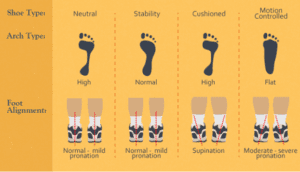
You may also look at the wear of a previous shoe to get an idea of what to select. See another image below.
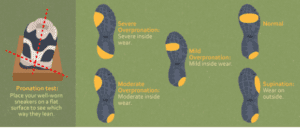
Now, another detail about the image above is the far left picture. Your shoe may start to lean one way or another after you buy it and use it for a while. For the purpose of running, never buy a shoe that has a lean new (without being used). This indicates poor support and heel alignment that will likely lead to injuries.
One final detail on choosing a shoe is the flex test. A nice, quality, more-than-rubber running sole with nice energy return and support will bend at the rear of the toe box, and no more than that. This will take a large load off of the tendons in your lower extremities. See the image below.
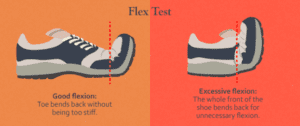
In closing, here is a good checklist for choosing your shoe, given these tips:
- Choose your store (knowledge and maybe pricing, NOT chosen on name. Local stores are typically more specialized)
- Try not to have bias
- Try on lots of pairs with a running specialist
- Check your foot (arch depth, pronation, shoe purpose)
- Check you shoe (slant test, flex test)
- Love the shoe!
Of course, the biggest thing of all, is that the shoe should feel great. You will likely put between 250-400 miles into these shoes before the cushion breaks down. Make the shoe your friend, and take time deciding. Plus, hey, who doesn’t love shoe shopping for recreational purposes. It’ll make you look forward to getting to “test that new pair out”. So make sure it counts, and make sure it’s something you love!
Photo by Snapwire, obtained via Pexels.com

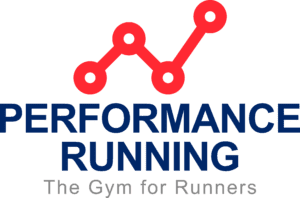
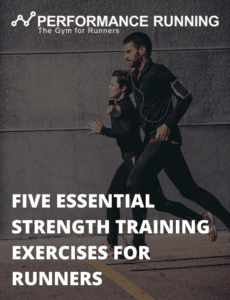

Recent Comments